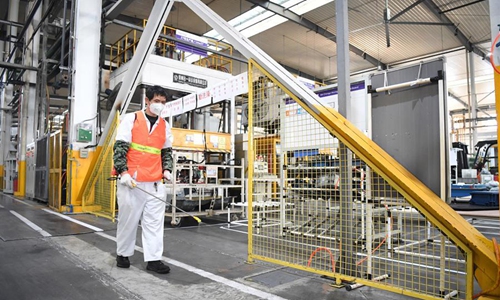HOME >> OPINION
Dual tasks of virus fight, work resumption
Source:Global Times Published: 2020/2/13 22:17:39

A worker disinfects the workshop in Faurecia (Chongqing) Automotive Parts Co., Ltd, a Sino-French joint venture, in Chongqing Airport Development Area in southwest China's Chongqing Municipality, Feb. 12, 2020. Under the guidance of concerning authorities, the company resumed production recently with comprehensive epidemic prevention measures. (Xinhua/Tang Yi)
The battle against the novel coronavirus pneumonia (COVID-19) has reached the most intense and complicated period. Central China's Hubei Province has demanded admission and treatment of all patients needing medical assistance. Hubei on Thursday announced 14,840 new cases, including 13,332 clinically diagnosed cases, as of midnight on Wednesday. The surge in the number is believed to be a release of the stock. Outside of Hubei, the newly confirmed cases announced on Thursday fell for the ninth consecutive day. The national control over the epidemic has produced results.
In places outside of Hubei, Chinese people are returning to work through trains and airplanes. They are bringing economic impetus as well as challenges to consolidating the prevention to these cities.
Public health and epidemic prevention work has never been carried out in an ideal and static environment, but in an intricate flow of people. It has come to a very complicated period right now.
The decline in new cases across China is the result of Hubei's being sealed off and the decisive prevention and control measures taken by each place more than 10 days ago. Now, people are returning to work, and it takes more than 10 days to fully show how it will affect the prevention and control of the virus. This is the real complexity of the situation: Should our prevention and control policy be based on the current results, or on the risks caused by people's return?
This is like gambling. Holding on to the harshest prevention measure while not going to work will stunt the spread of the epidemic, but it also means we will lose a couple of days. But if work is resumed now, we will suffer fewer economic losses, but we will face higher risk that the epidemic will spread.
What should each place do? We suggest science be insisted. We must insist on scientific decision-making and get rid of all kinds of distracting thoughts and the officials-come-first mentality to ensure people's safety and the healthy development of the economy.
First, the prevention and control system must not be weakened. We must pay great attention to the risk of epidemic spread caused by people's return.
Second, the prevention and control should be focused more on scientific epidemiological tracking and monitoring, instead of blindly implementing general measures.
Third, the resumption of activities related to production and city functioning must accelerate on the condition that strict preventive measures are implemented. Working from home should be promoted in all sectors, including manufacturing. In the next two weeks, various companies and organizations should adopt the principle of minimizing the number of employees at the office as long as they can function normally so as to reduce the risk of the epidemic spreading brought about by the resumption of work.
Fourth, transportation must reopen and basic social logistics network must resume. There should not be any such case that materials or products of some companies cannot move in or out. Fifth, general public should also restrict outdoor contact as much as possible.
The national prevention and control network has been set up and is in effective operation. As China attaches great importance to the fight against the epidemic, the possibility of a new out-of-control outbreak is very low. But we should remain vigilant. We need to accelerate the recovery of production and consolidate prevention and control, so as to achieve the victory ahead.
Posted in: EDITORIAL